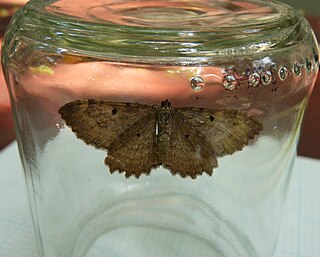
Cabera is a genus of moths in the family Geometridae described by Georg Friedrich Treitschke in 1825.
Celonoptera is a monotypic moth genus in the family Geometridae. Its only species, Celonoptera mirificaria, is found in south-eastern Europe. Both the genus and species were first described by Julius Lederer in 1862.

Coryphista is a monotypic moth genus in the family Geometridae erected by George Duryea Hulst in 1896. The genus may be considered to be a synonym of Rheumaptera. Its only species, Coryphista meadii, the barberry geometer moth or barberry looper, was first described by Alpheus Spring Packard in 1874. It is found in the United States and southern Canada.

Digrammia was a genus of moths in the family Geometridae erected by Carl Freiherr von Gumppenberg in 1887. It is now often considered a synonym of Semiothisa.

Episemasia is a genus of moths in the family Geometridae first described by George Duryea Hulst in 1896.
Eriplatymetra is a genus of moths in the family Geometridae erected by Augustus Radcliffe Grote in 1873.
Euacidalia is a genus of moths in the family Geometridae described by Packard in 1873.

Eufidonia is a genus of moths in the family Geometridae first described by Packard in 1876.

Eumacaria is a monotypic moth genus in the family Geometridae described by Packard in 1873. Its only species, Eumacaria madopata, the brown-bordered geometer moth, was first described by Achille Guenée in 1857. It is found in North America, where it has been recorded from British Columbia, northern Washington, southern Saskatchewan, from Maine to Florida, South Dakota, North Dakota, Nebraska, Wyoming, Idaho, Colorado and New Mexico. The habitat consists of orchards and shrublands. The species is listed as threatened in Connecticut.
Eurhinosea is a monotypic moth genus in the family Geometridae. Its only species, Eurhinosea flavaria, is found in western North America. The genus and species were both described by Packard in 1873.
Ithysia is a monotypic moth genus in the family Geometridae. Its only species is Ithysia pravata. The genus was erected by Jacob Hübner in 1825, but the species had been first described by Hübner in 1813.
Loxofidonia is a genus of moths in the family Geometridae described by Packard in 1876.

Nemoria is a genus of emerald moths in the family Geometridae. It was named by Jacob Hübner in 1818.

Orthofidonia is a genus of moths in the family Geometridae first described by Packard in 1876.
Pherne is a genus of moths in the family Geometridae described by George Duryea Hulst in 1896.

Plataea is a genus of geometrid moths in the family Geometridae. There are about 11 described species in Plataea.
Protitame is a genus of moths in the family Geometridae erected by James Halliday McDunnough in 1939.

Sicya is a genus of moths in the family Geometridae erected by Achille Guenée in 1857.
Somatolophia is a genus of moths in the family Geometridae described by George Duryea Hulst in 1896.
Scopula candidaria is a moth of the family Geometridae. It was described by Warren in 1902. It is found in Kenya, the Democratic Republic of Congo and Uganda.











